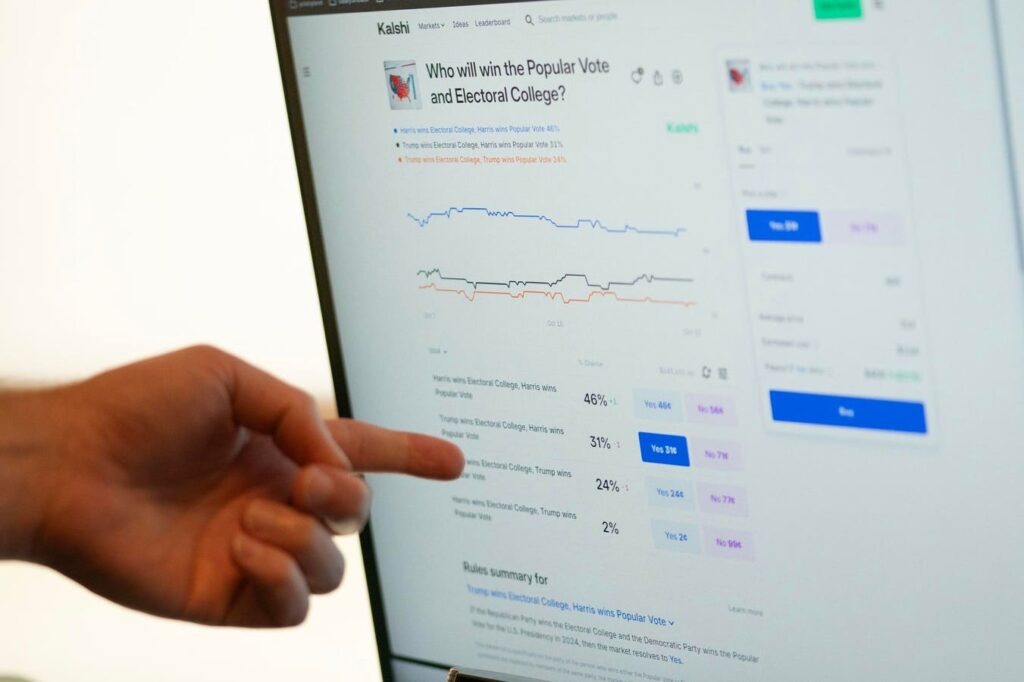In the aftermath of the 2024 presidential election, much attention has focused on the implications of President Trump’s historic return to the White House. Yet another significant story has emerged: the failure of prediction markets to provide reliable forecasting during the pivotal contest between Trump and his opponent, Kamala Harris.
Prediction markets are exchange-traded markets where participants can bet on the outcomes of future events. The theory behind them is actually compelling: by aggregating the views of numerous participants willing to put real money behind their beliefs, these markets may produce more accurate forecasts than polls or expert opinions. When functioning efficiently, the market price in a prediction market can represent the probability of an event occurring.
The landscape for prediction markets in the United States changed significantly this year when the Commodity Futures Trading Commission (CFTC) was forced to allow Kalshi’s political betting markets. As a result of a court ruling, Americans could legally bet on election outcomes through this regulated U.S.-based platform. Along with offshore competitors like Polymarket and PredictIt, these venues promised to bring new clarity to electoral forecasting.
Instead, they delivered significant confusion and contradiction. Throughout the campaign, Kalshi and Polymarket frequently showed dramatically different probabilities for the same outcome. One market would show Vice President Harris as the likely winner while the other favored Trump–a situation that should be impossible in efficient markets. In theory, such discrepancies create risk-free arbitrage opportunities: traders could bet on the lower-priced candidate in each market, guaranteeing a profit regardless of the outcome.
While transaction costs might explain small differences, the persistent large gaps across markets suggests other factors were at play. One is the apparent ability of individual traders to significantly move these markets. The most notable example was a French investor known as “Freddi9999,” whose large pro-Trump bets on Polymarket appeared to single-handedly shift that platform’s odds. There is speculation that Harris supporters may have responded by pushing up her price on Kalshi, effectively turning these prediction markets into another form of campaign advertising.
This phenomenon illustrates what economist Robert Lucas identified in his famous critique of economic policy evaluation: once a measure becomes a policy target, it loses its reliability as an indicator because people adjust their behavior in response. While Lucas was primarily concerned with monetary policy metrics, his insight applies equally to prediction markets. When these markets are viewed as influential indicators, they become vulnerable to manipulation by those seeking to shape public perception.
Some prediction markets remained inconsistent right up until election day, with PredictIt and Polymarket still showing conflicting probabilities just days before voters went to the polls. Some defenders point to how quickly these markets identified Trump as the winner on election night, before major networks made their official calls. However, this is hardly impressive. The New York Times election needle and other related indicators were similarly quick to suggest Trump’s advantage as results came in. In fact, betting markets were likely reacting to the same publicly available vote counts and analysis that informed the media forecasting tools, as opposed to providing unique insights.
This is not to say prediction markets are not useful. They can provide valuable information when properly structured and when participants are trading based on genuine information. However, the 2024 election demonstrated their limitations, particularly in high-stakes political contests where the incentive to manipulate outcomes is strong.
The lesson is clear: while prediction markets can be useful tools in our forecasting arsenal, their imperfect accuracy as well as vulnerability to manipulation, means they must be viewed as just one of many inputs in understanding likely outcomes. The 2024 election proved that these markets work best when they complement rather than replace traditional forecasting methods–and when we maintain healthy skepticism about their predictive power.
As we look ahead to future elections, we would do well to remember that no single forecasting tool is infallible. Betting markets offer useful insights at times, but the case for them having any more important role in society beyond as a source of entertainment, such as in a policy making context, is narrow. Sometimes, as in 2024, their greatest contribution might be showing us the limitations of our forecasting capabilities.
Read the full article here










